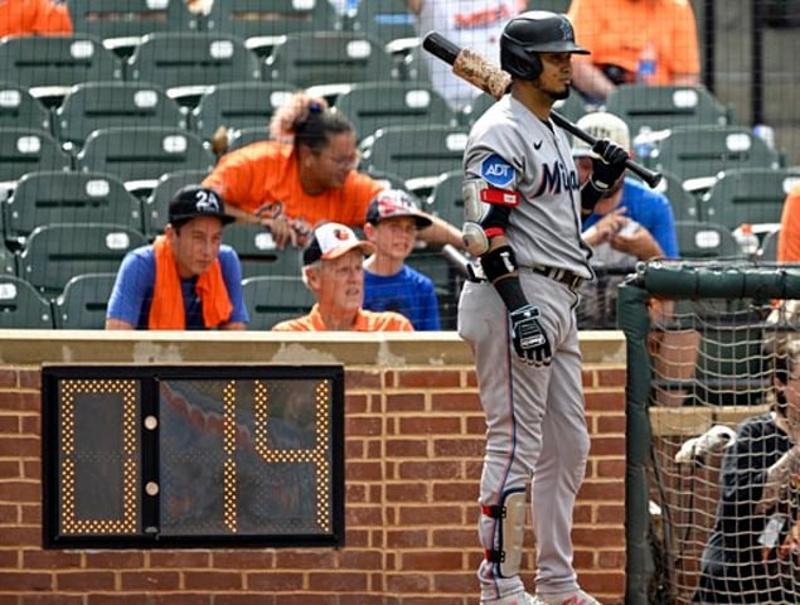In the first year of the pitch clock in Major League Baseball, the average time of a nine-inning game decreased by 24 minutes, resulting in faster-paced games. This article explores the impact of the pitch clock on the game, including the spike in batting average and the most stolen bases in nearly 40 years. Get ready to discover the highlights of this season of change in MLB.
The Impact of the Pitch Clock
Exploring the overall impact and significance of the pitch clock in Major League Baseball.
The introduction of the pitch clock in Major League Baseball has resulted in significant changes to the pace and dynamics of the game. Always at the center of controversies and debates, the pitch clock has made a noticeable impact on the game.
With the average game time decreasing by 24 minutes in its first year of implementation, the pitch clock has brought about faster-paced games that keep fans engaged. Let's dive deeper into how the pitch clock has influenced various aspects of the game.
A Spike in Batting Average
Analyzing the increase in batting average under the new pitch clock rule.
One of the most significant effects of the pitch clock is the increase in batting average across the league. With less time for pitchers to establish their rhythm and hurl pitches, batters have found an advantage and capitalized on the opportunity.
The shorter intervals between pitches force pitchers to act swiftly, potentially leading to more mistakes and inconsistency in pitch quality. As a result, batters have been able to connect more successfully and achieve higher batting averages.
This uptick in batting average brings a renewed excitement to the game, as fans witness a greater display of offensive power and skill.
Runner Exploitation and Stolen Bases
Examining the impact of decreased base distances and greater runner exploitation in the era of the pitch clock.
The introduction of the pitch clock has led to a decrease in base distances, resulting in significantly more runner exploitation and stolen bases in the game. With the slightly shortened distance between each base, runners have a better chance to steal bases.
This change in gameplay has energized the game, bringing back the era of daring and strategic baserunning. The newfound emphasis on speed and agility has added an additional layer of excitement to the sport, engaging fans and providing new opportunities for teams to strategize.
Teams are now adapting to this new aspect of the game, developing specialized individuals skilled in taking advantage of the shorter distances in their plays, further paving the way for thrilling moments on the field.
Left-Handed Hitters Finding Success
Examining how the restrictions on defensive shifting favor left-handed hitters and provide a competitive edge.
With new restrictions on defensive shifts, left-handed hitters have found increased success in the era of the pitch clock. The requirement for defensive players to play within certain positions at specific times creates better opportunities for left-handed batters at the plate.
Historically faced with frequent defensive shifts, left-handed batters often struggle to find space and take advantage of their natural strengths. However, with the limitations introduced by the pitch clock, the effectiveness of defensive shifts is significantly reduced, offering left-handed hitters more room to showcase their skills and impact the game.
For left-handed batters, this rule change presents a unique advantage and gives them a renewed edge in their performances, leading to an overall increase in the batting average of left-handed hitters.
Conclusion
The introduction of the pitch clock has brought about significant changes to Major League Baseball, resulting in faster-paced games and an increase in offensive performance. The shorter game times have kept fans engaged throughout and have allowed for a greater display of batting skills and strategic baserunning.
Left-handed hitters have notably benefited from the restrictions on defensive shifts, finding more success at the plate. The increased exploitation of base distances has led to an exciting surge in stolen bases, bringing back a sense of unpredictability and thrilling moments to the game.
Overall, the impact of the pitch clock has been positive, rejuvenating the game and providing new dynamics on the field. The results of the first year have shown promising changes, and it remains to be seen how further adjustments may enhance the game and maintain excitement for players and fans alike.
FQA :
How has the pitch clock affected pitching?
The pitch clock has forced pitchers to act swiftly and reduced their time deliberating on pitches. This can potentially lead to more mistakes and inconsistency in pitch quality, providing an advantage for batters.
Have there been any negative impacts of the pitch clock?
While the pitch clock has brought various positive changes to the game, some pitchers and teams may need time to adjust to the faster pace. Additionally, the timeframe for decision-making might limit certain strategic aspects of the game.
What other impacts has the pitch clock had on the game?
In addition to shorter game times, the pitch clock has increased the focus on baserunning and stolen bases, creating thrilling moments on the field. It has also facilitated greater fan engagement and excitement with the surge in offensive performances.

